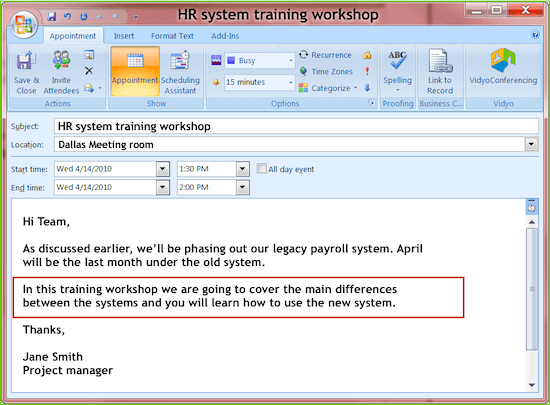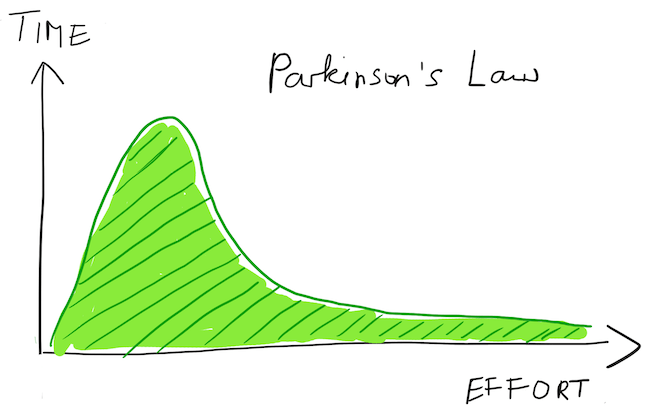Meetings …. aaaah. They are usually boring, provide little value and eat so much of our precious time that we often go home thinking “what did I do all day?”.
The thing is: meetings aren’t bad per se. It’s the way they are carried out.
Over the past years I’ve hosted hundreds of project meetings, and I’ve learned a lot from it. In this article I want to pass on my best tips to you. Apply them and your meetings will be 100 times more effective.
Tips for good meetings
The “secret” to a successful meeting: have a goal
Don’t focus too much on the process. Think about the outcome you want to achieve with a meeting. By having a clear picture of the outcome, you can better involve meeting participants. And a clear understanding of the outcome will allow you to steer the meeting in the right direction.
Examples of goals:
- “I want people to understand the purpose of the project and how they have to contribute.”
- “I want to find out what exactly the customer is not happy with.”
- “I want the group to define a concept that works for all departments.”
- “I want to restore a good relationship with my coworker.”
Write it down for yourself on a piece of paper.
My advice: Put your expectations directly into the meeting invite so people are primed:

Duration: How long should your meeting be?
You won’t automatically accomplish more in a 2 hour meeting as in a 1 hour meeting. Why? Because when we have more time, we tend to overcomplicate things and to stretch discussions that could otherwise be completed in less time. This is called Parkinson’s Law, and it says that work expands to fill the time available for its completion.
On a graph it looks like this:

I can confirm this from my own experience. I used to schedule meetings for 90 minutes or more, and still they would not deliver clear results. Then I changed my approach. I used short 30 minute meetings to sort out specific issues. They were really effective because everyone was so focused and we knew we didn’t have much time. 1 and 2 hour meetings became the exception.
What should you take away from this?
Cut meeting time short. You think you need 2 hours? Schedule a 1 hour meeting. Feel like 1 hour is not enough? Block 30 minutes instead. To make sure you don’t run out of time, focus on making your meeting more effective by guiding the discussion and interrupting when the conversation gets off topic (I’m covering this point further down in this post).
Prepare an agenda
Always walk into a meeting well-prepared. Know what you are going to say and have a defined agenda. I know you’ve heard this before, but it’s really important. Your agenda can be very simple, just a list of bullet points with topics you want to go through:
- project goal
- project timeline
- project organization
- questions & answers
By having an agenda you’ll always know what to say next and you won’t forget to bring up all important topics.
Send out pre-reading material
Some meetings serve the purpose of getting buy-in or approval from stakeholders. For instance, you want management to approve extra budget for your project. Or you want to get your business case approved.
Taking people from zero (where they don’t know anything about your issue) to a stage where they can make an informed decision may not be possible in a 1 or 2 hour meeting. The topic may just be too complex.
The best way to handle this kind of scenario is to share pre-reading material with the meeting audience upfront. You prepare a few slides, add in any numbers you want to show and send out the material 1-2 weeks before the meeting. The advantage? Everyone who’s coming to your meeting will already have enough background information so that you can directly jump into a Q&A session without having to go through the entire topic.
Get personal before you talk business
Here’s a common misconception: Having better arguments or giving more facts will help you win in a meeting. That’s not true. For sure you need good reasons why people should support your proposal or your project. But good reasons alone will only get you this far.
What is much more powerful than good reason: Having a strong bond with people. Not just being a respected leader, but being respected and liked by your team. This is of course much harder to achieve than finding strong arguments to support your case.
How can you connect with people on a personal level, even when there’s not much time available for socializing? You give attendees a warm welcome and start with discussing personal topics instead of work stuff.

Say things like: “Hey Joanne, great to see you again. How did the move go? Are you happy with your new place? How are the kids? Oh, wow they are already going to school. How time flies.”
THAT’S HOW YOU WIN OVER OTHERS. It’s what’s called small talk. When you talk personal stuff, people open up. They start to enjoy being in a meeting with you. And they will more inclined to help or support you. That’s why the 5 minutes of small talk before every meeting are a great investment.
Get everyone up to the same level
There’s you, the meeting host. And there are the meeting participants. You are already highly familiar with the topic that’s going to be discussed. You audience may not be as familiar with it as you think. And that’s a problem. How are they supposed to make decisions or contribute in a meaningful way if they don’t have the same knowledge as you?
That’s why every meeting should start with sharing background and giving context about the discussion points. Ask youself: What do people need to know or be aware of so they can make an informed decision?
Provide background information:
- Background information about the project
- What your goal is
- What has been tried before
- Why a particular decision was taken
- What options were evaluated
Stop, we are getting off topic
Meetings have a tendency to go completely off topic if the host does not properly facilitate the process. Participants pick up a side topic and start to talk about minutiae.
You: “We are going to fly to New York next month.”
Participant: “Are we flying business class?”
Other participant: “Not Delta please.”
Other participant: “United is my favorite”
People are only attending the meeting as guests, they have no incentive to make the meeting successful. That’s why you need to chime in and bring the conversation back to the original topic:
You: “Please, let us get back to the topic we’re actually trying to solve!”
You will have raise your voice and support your order with proper body language, such as standing up or clapping on the desk with your hand or a pen.
The challenge when leading meetings is to know when to stop the discussion and when to let it continue. Very often, people get into issues that are somehow relevant to the topic but still are not worth talking about because they don’t really matter. If you’re not well-versed in the subject matter you don’t know if this issue big enough to justify a deeper discussion within the meeting.
Let’s say you are discussing x options for y and one participant
These questions help you gauge the importance of a point:
- Why is <point> important?
- What would be the impact if we ignored <point>?
- Would we still be able to achieve our goal if we ignored <point>?
Keep an eye on the time
If you’ve covered 3 out of 5 agenda items and still have 50% of meeting time left, that’s good. But suppose you’ve covered 2 out of 5 agenda points but have only 10 minutes left, that’s not good. You need to manage time.
How?
Speed up the discussion by calling into people’s minds the little amount of time left: “Hey guys, we have only 15 minutes left so please be concise and focus on our topic.”
You can also skip an agenda point if you think it can wait, and instead use the extra time to focus on the remaining topics.

Write the minutes (better)
Did we really say that? No, that’s not what we discussed. It’s really annoying when you’ve spent hours in a meeting and later, discussions or questions pop up because the meeting results were not documented. Therefore always write the minutes. Even if it’s just a brief email with pullet points.
My recommendation: don’t just record the final results or decisions. These are of course important to know. But minutes are most effective when they also give context and include the thought process behind a decision: Why was a specific decision taken instead of another? By including this information you will get back fewer questions back, especially from people who haven’t been on the meeting.
What’s your experience with meetings?
I’d love to hear what has been your experience running or attending meetings? Tell me one thing you would do differently? Or a technique that has worked really well for you. Leave a comment!
Author
-
Hi, I’m Adrian, a Senior Project Manager and the Creator of Tactical Project Manager, where I teach a pragmatic approach to project management. Led large-scale IT and business projects for over 10 years. My goal is to enable you to lead any project with confidence.
View all posts



